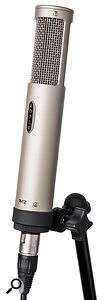Royer have powered up their most affordable ribbon mic with active electronics.
 David Royer might be the most influential microphone designer in the business today. When he set up Royer Labs back in the ’90s, the ribbon mic was a moribund technology, largely forgotten by the studio world. Royer’s first product, the R‑121, demonstrated not only that there was a place for ribbon mics in contemporary recording, but that there was still scope for technological innovation, thanks to developments such as rare‑earth magnets and Royer’s then‑unique ‘offset ribbon’ motor.
David Royer might be the most influential microphone designer in the business today. When he set up Royer Labs back in the ’90s, the ribbon mic was a moribund technology, largely forgotten by the studio world. Royer’s first product, the R‑121, demonstrated not only that there was a place for ribbon mics in contemporary recording, but that there was still scope for technological innovation, thanks to developments such as rare‑earth magnets and Royer’s then‑unique ‘offset ribbon’ motor.
Not content with reinvigorating ribbons, David went on to set up Mojave Microphones to commercialise his ideas around capacitor mic design. Meanwhile, the R‑121 is still widely regarded as the gold standard for recording electric guitar amps, among other things. As befits a premium US‑made mic, however, the R‑121 is relatively costly, and perhaps out of the reach of many people who would like to own one.
With this in mind, Royer first created the R‑101, and then later the R‑10, aiming to boil down the essential qualities of the flagship model into a more affordable package. The latter mic was reviewed by Hugh Robjohns in the January 2018 issue of SOS and remains a current product. It has now been joined by a sister mic called the R‑12.
Attractive Active
One of Royer’s biggest innovations came in 2002 with the launch of the R‑122: an active, phantom‑powered version of the R‑121, with a sensitivity comparable to most capacitor microphones and the ability to drive long cable runs without the sound suffering. On paper, the concept of an active ribbon mic sounds trivial to realise, but in practice, Royer had to overcome significant technical hurdles to get it to work, as the company’s co‑founder Rick Perrotta explains in the boxout. In Royer’s approach, the active circuitry doesn’t provide any amplification as such. Rather, it acts as a buffer and line driver, the extra sensitivity coming from the use of a transformer with much higher voltage gain than can be employed in a passive mic.
In Royer’s approach, the active circuitry doesn’t provide any amplification as such. Rather, it acts as a buffer and line driver, the extra sensitivity coming from the use of a transformer with much higher voltage gain than can be employed in a passive mic.
The R‑122 is also still a current product, and its present MkII iteration features a switchable high‑pass filter and ‑15dB pad. Both of those features have been carried over into the new R‑12 — which, as you’ve probably twigged by now, is an active version of the R‑10. Like the R‑122, it achieves its extra sensitivity by the use of a special output transformer, which is stabilised by an active buffer. One benefit of Royer’s approach is that the R‑12 can handle sound pressure levels up to an ear‑melting 160dB.
Twelve...
You are reading one of the locked Subscribers-only articles from our latest 5 issues.
You've read 30% of this article for FREE, so to continue reading...
- ✅ Log in - if you have a Digital Subscription you bought from SoundOnSound.com
- ⬇️ Buy & Download this Single Article in PDF format £0.83 GBP$1.49 USD
For less than the price of a coffee, buy now and immediately download to your computer, tablet or mobile. - ⬇️ ⬇️ ⬇️ Buy & Download the FULL ISSUE PDF
Our 'full SOS magazine' for smartphone/tablet/computer. More info... - 📲 Buy a DIGITAL subscription (or 📖 📲 Print + Digital sub)
Instantly unlock ALL Premium web articles! We often release online-only content.
Visit our ShopStore.
